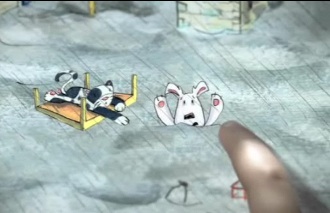This article is more than 1 year old
Ad industry OKs climate porn
You write the cheques, we'll drown the puppies
The UK advertising industry has bravely decided it can continue to accept millions of pounds from the state to create alarming climate advertisements, despite inaccuracies and a storm of complaints from parents. The principled decision, from the admen's self-regulatory body the ASA, follows 939 complaints about the UK energy ministry DECC's "Drowning Dog" prime time TV and cinema ad (aka "Bedtime Story") , which cost £6m, and four related posters.
Critics aren't happy, and point out that the chair of the ASA, Lord Chris Smith of Finsbury, also chairs the Environment Agency, and is currently working closely with DECC.
The ASA dismissed complaints against the TV ad, although it upheld complaints against two of the related poster advertisements, and has requested they not be run again. On the charge that the campaign was political, ASA deferred to OFCOM, which is continuing to investigate the advertisements, and has not yet made a decision.

The TV and cinema ad predicted "awful heat waves" and "terrible storms and floods" for the future, claiming that life would be "very different in 26 years" if people failed to make decisions such as living in colder houses, or using less transportation. The ASA examined 'Drowning Dog' on the grounds it was misleading, was not based on objective evidence, and caused unnecessary personal distress.
In its defence, DECC cited reports from the UN's IPCC panel, and the ASA agreed there was an "overwhelming consensus in the global community of climate scientists" backing this particular climate theory. The ASA believed the IPCC to be objective and independent, and concluded there was "not a significant division of opinion" amongst scientists on the theory.
Therefore, the ASA found that "the level of discomfort was proportionate to the risk". It also noted that as the child's (cartoon) dog drowned, "the child showed wonder rather than fear or distress". An appeal to fear is justified in the CAP Code's marketing guidelines, said the ASA.
The ASA panel said that to reflect the computer models from which the predictions originated, but said they were justified.
Surprisingly the ASA even supported the ad's claim that 40 per cent of CO2 in the atmosphere came from humans doing "ordinary every day things". In fact, human CO2 emissions are a much smaller proportion (3.5 per cent) of total CO2 emissions. Here's how the ASA squared the circle:
Because the claim "over 40% of the C02 was coming from ordinary every day things like keeping houses warm and driving cars" was preceded by those qualifications and was accompanied by images of human activity in a typical UK town, such as cars driving along streets and lighting in houses, we considered it would be clear to most viewers that the ad was discussing increasing levels of C02 and that the claim "over 40% of the C02 was coming from ordinary every day things like keeping houses warm and driving cars" referred not to total C02 in the global atmosphere, but to C02 produced by human activities in the UK.
Posters produced by the Energy ministry didn't fare so well.
